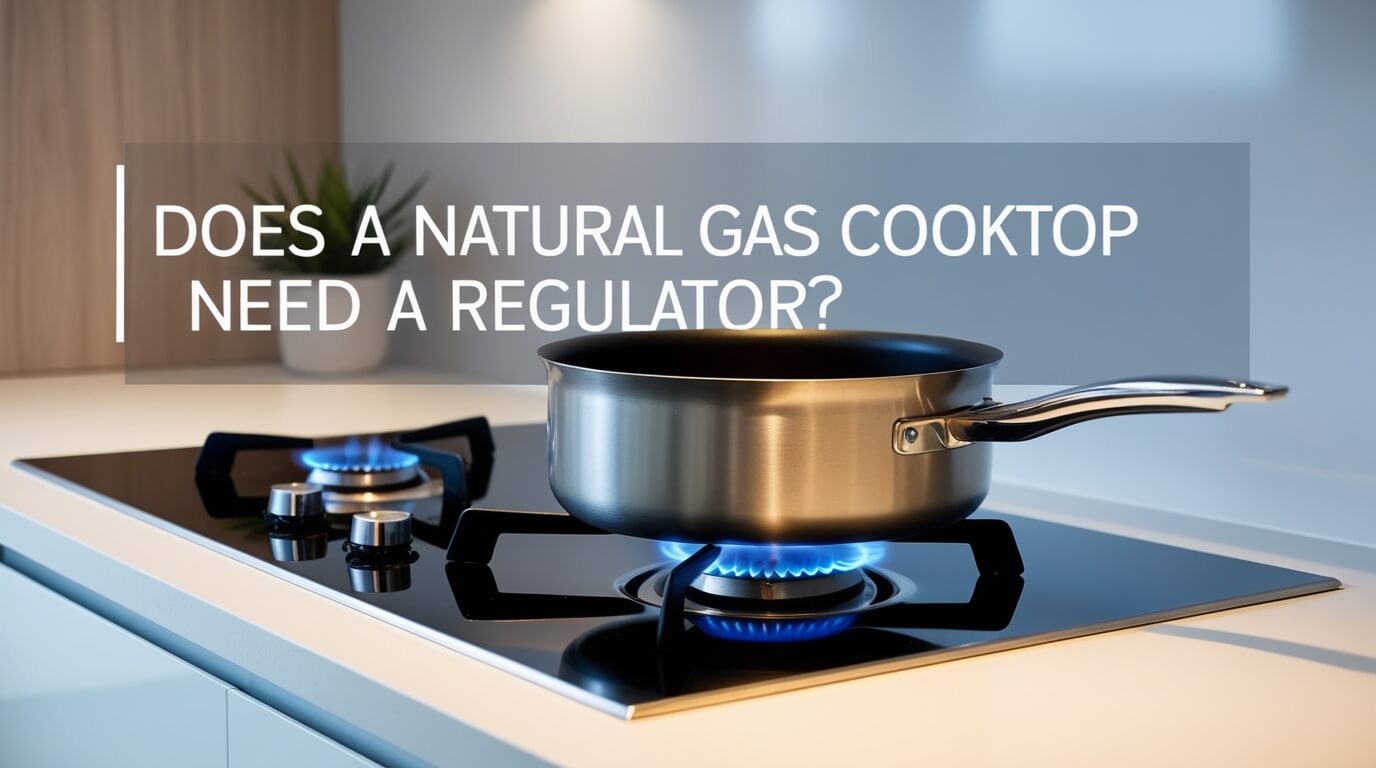
If you’re considering a natural gas cooktop for your kitchen, you might be wondering: does a natural gas cooktop need a regulator? The short answer is yes, most natural gas cooktops require a regulator to function safely and efficiently. Regulators play a crucial role in controlling gas pressure, ensuring your cooktop operates as intended. In this comprehensive guide, we’ll explore why regulators are essential, how they work, and what you need to know about them for your natural gas cooktop.
What is a Natural Gas Regulator?
Before diving into the specifics of cooktop regulators, let’s understand what a natural gas regulator is and why it’s important.
Definition and Purpose
A natural gas regulator is a device that controls the pressure of gas flowing from your home’s main supply line to your appliances. Its primary purpose is to reduce the high pressure in the main gas line to a lower, consistent pressure that’s safe for your cooktop and other gas appliances.
How Gas Regulators Work
Gas regulators use a simple yet effective mechanism:
- Gas enters the regulator at high pressure
- A diaphragm inside the regulator responds to pressure changes
- The diaphragm adjusts a valve, controlling gas flow
- Gas exits the regulator at a lower, stable pressure
This process ensures that your cooktop receives gas at the right pressure, regardless of fluctuations in the main supply line.
The Importance of Gas Pressure Control
Controlling gas pressure isn’t just about efficiency – it’s a matter of safety and performance for your natural gas cooktop.
Safety Considerations
Proper gas pressure is crucial for safe operation. Too much pressure can lead to:
- Gas leaks
- Excessive flame size
- Incomplete combustion, producing harmful carbon monoxide
A regulator acts as a safety valve, preventing these dangerous scenarios.
Efficiency and Performance
The right gas pressure also ensures:
- Consistent flame size
- Even cooking temperatures
- Optimal fuel efficiency
Without a regulator, your cooktop’s performance could be unpredictable and inefficient.
Natural Gas Supply Systems
To understand why regulators are necessary, let’s look at how natural gas gets from its source to your cooktop.
From Well to Home
Natural gas travels a long way before reaching your home:
- Extraction from underground wells
- Processing to remove impurities
- Transportation through high-pressure pipelines
- Distribution to local networks
At each stage, the gas pressure changes to suit different needs.
Pressure Variations in the Distribution Network
Gas pressure in the main distribution lines can be much higher than what your appliances need:
- Main lines: Up to 1,000 psi (pounds per square inch)
- Local distribution lines: 60 psi or less
- Home supply lines: 1/4 to 1/2 psi
Your cooktop typically needs even lower pressure, around 4 inches of water column (about 0.15 psi).
Types of Gas Regulators
There are several types of regulators in the natural gas supply chain, each serving a specific purpose.
Main Line Regulators
These large regulators reduce pressure from transmission pipelines to distribution networks. They’re typically managed by gas companies and aren’t something homeowners need to worry about.
Service Line Regulators
Found near your gas meter, these regulators reduce pressure from the street supply to a level safe for your home’s pipes.
Appliance Regulators
These are the regulators we’re most concerned with for cooktops. They make the final pressure adjustment to suit your specific appliance.
Do All Natural Gas Cooktops Require a Regulator?
Now, let’s address the main question: does every natural gas cooktop need a regulator?
Factory-Installed Regulators
Many modern cooktops come with built-in regulators. These are typically:
- Pre-set to the correct pressure
- Located inside the cooktop, often near the gas inlet
If your cooktop has a factory-installed regulator, you usually don’t need an additional external one.
Standalone Regulators
Some cooktops, especially older models or commercial-grade units, may require a separate regulator. These are installed:
- Between the gas supply line and the cooktop
- Usually close to the appliance for easy access
Exceptions to the Rule
While most natural gas cooktops need regulators, there are a few exceptions:
- Some high-end professional-grade cooktops designed for variable pressure
- Certain outdoor cooking appliances with specific designs
Always check your cooktop’s manual or consult with a professional to be sure.
Benefits of Using a Gas Regulator for Cooktops
Using a properly functioning regulator with your natural gas cooktop offers several advantages.
Consistent Cooking Performance
A regulator ensures:
- Steady flame size
- Reliable heat output
- Predictable cooking times
This consistency is crucial for achieving great results in your cooking.
Extended Appliance Lifespan
By protecting your cooktop from pressure fluctuations, a regulator can help:
- Reduce wear on internal components
- Prevent damage from excessive gas flow
- Maintain optimal operating conditions
This can significantly extend the life of your cooktop.
Energy Efficiency
Proper gas pressure leads to more efficient fuel use:
- Less wasted gas
- Lower energy bills
- Reduced environmental impact
A well-regulated cooktop is good for both your wallet and the planet.
Potential Risks of Operating Without a Regulator
Using a natural gas cooktop without a proper regulator can lead to several issues.
Inconsistent Flame Size
Without regulation, you might experience:
- Flames that are too large or too small
- Difficulty controlling cooking temperature
- Uneven heating across burners
These issues can make cooking frustrating and unpredictable.
Incomplete Combustion
Improper gas pressure can cause:
- Yellow or orange flames instead of blue
- Production of carbon monoxide
- Soot buildup on pots and pans
These are signs of incomplete combustion, which can be dangerous and inefficient.
Appliance Damage
Over time, unregulated gas flow can cause:
- Wear on valves and burners
- Damage to internal components
- Shortened lifespan of your cooktop
Protecting your investment with a regulator makes good financial sense.
How to Determine if Your Cooktop Needs a Regulator
If you’re unsure whether your cooktop has or needs a regulator, here’s how to find out.
Checking the Manual
Your cooktop’s manual should specify:
- Whether a regulator is included
- If an external regulator is needed
- Recommended gas pressure settings
Always start with the manufacturer’s documentation.
Inspecting the Cooktop
Look for these signs of a built-in regulator:
- A small cylindrical device near the gas inlet
- Labels mentioning “pressure regulator” or “gas regulator”
- Adjustment screws or caps on the back or bottom of the unit
If you can’t find these, you might need an external regulator.
Consulting a Professional
When in doubt, consult:
- A licensed plumber
- A gas appliance technician
- Your local gas company
These professionals can assess your setup and advise on regulator needs.
Installing a Gas Regulator for Your Cooktop
If you need to install a regulator, here’s what you should know.
DIY vs. Professional Installation
While some homeowners might be tempted to install a regulator themselves, it’s generally best to hire a professional. Here’s why:
- Gas work requires specific skills and knowledge
- Improper installation can be dangerous
- Many areas require licensed professionals for gas work
The safety benefits outweigh any potential cost savings from DIY.
Step-by-Step Installation Guide
For those who are qualified, here’s a basic overview of the installation process:
- Turn off the gas supply
- Disconnect the cooktop from the gas line
- Install the regulator close to the cooktop
- Connect the regulator to the gas line and cooktop
- Check all connections for leaks
- Adjust the regulator to the correct pressure
- Test the cooktop for proper operation
Remember, this is a simplified guide. Always follow manufacturer instructions and local codes.
Safety Precautions
When working with gas appliances, always:
- Ensure proper ventilation
- Use appropriate tools and materials
- Have a fire extinguisher nearby
- Know how to shut off the main gas supply
- If you smell gas, leave the area and call your gas company immediately
Safety should always be your top priority.
Maintaining Your Gas Regulator
Once installed, your gas regulator needs occasional attention to keep working properly.
Regular Inspection Tips
Periodically check your regulator for:
- Signs of corrosion or damage
- Proper mounting and stability
- Clear vents (for outdoor regulators)
A visual inspection every few months can catch potential issues early.
Signs of Regulator Failure
Watch for these warning signs:
- Fluctuating flame size
- Unusual noises from the regulator
- Gas odors near the connections
- Difficulty lighting burners
If you notice any of these, call a professional for inspection.
When to Replace Your Regulator
Most regulators last 10-15 years, but replacement might be needed if:
- The regulator shows visible damage
- You experience persistent gas pressure issues
- Your cooktop is very old and you’re upgrading other components
When in doubt, consult a professional about replacement.
Regulations and Codes for Gas Cooktop Installation
Installing or modifying gas appliances is subject to various regulations.
National and Local Building Codes
Be aware of:
- National Fire Protection Association (NFPA) standards
- International Fuel Gas Code requirements
- State and local building codes
These regulations ensure safe installation and operation of gas appliances.
Manufacturer Guidelines
Always follow:
- Specific installation instructions for your cooktop model
- Recommended regulator types and settings
- Any special requirements for your particular appliance
Ignoring manufacturer guidelines could void your warranty and create safety hazards.
Troubleshooting Common Gas Regulator Issues
Even with a regulator, you might encounter some issues. Here’s how to address them.
Low Flame Problems
If your flames are consistently low:
- Check if the regulator is set correctly
- Ensure the gas supply valve is fully open
- Look for kinks in the gas line
- Consider having the regulator checked for malfunction
Low flames can indicate insufficient gas pressure.
High Flame Issues
Excessively high flames might mean:
- The regulator is set too high
- There’s a problem with the regulator’s internal components
- The wrong type of regulator is installed
High flames can be dangerous and should be addressed immediately.
Irregular Flame Patterns
If flames are uneven or flickering:
- Clean the burner ports
- Check for drafts near the cooktop
- Ensure the burner caps are properly seated
- Consider having the regulator inspected
Irregular flames often indicate problems with gas flow or burner condition.
Frequently Asked Questions About Gas Cooktop Regulators
Let’s address some common questions about natural gas cooktop regulators.
Can I Use a Universal Regulator?
While universal regulators exist, it’s best to use:
- The regulator recommended by your cooktop manufacturer
- A model specifically designed for your gas type and pressure needs
Universal regulators may not provide optimal performance for all cooktops.
How Often Should I Replace My Regulator?
Generally:
- Every 10-15 years for residential use
- More frequently for commercial or heavy use
- Immediately if you notice any malfunction or damage
Regular inspections can help determine when replacement is necessary.
What’s the Difference Between Natural Gas and Propane Regulators?
The main differences are:
- Operating pressure ranges
- Connection types
- Safety features specific to each gas type
Never use a propane regulator for natural gas or vice versa.
Conclusion: Ensuring Safe and Efficient Natural Gas Cooktop Operation
In conclusion, most natural gas cooktops do need a regulator to function safely and efficiently. Whether built-in or external, regulators play a crucial role in controlling gas pressure, ensuring consistent performance, and protecting both your appliance and your home.
Remember:
- Check your cooktop’s manual for regulator requirements
- Have a professional install or inspect your regulator
- Maintain your regulator and be aware of signs of malfunction
- Always prioritize safety when dealing with gas appliances
By understanding the importance of gas regulators and following proper installation and maintenance procedures, you can enjoy safe, efficient, and consistent cooking with your natural gas cooktop for years to come.






